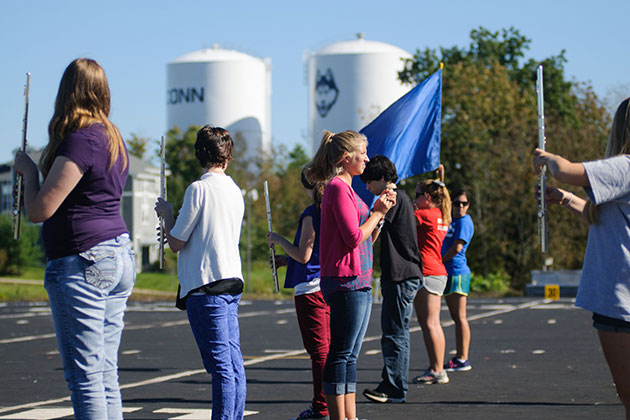
Despite the multitasking skills that today’s high school students demonstrate throughout their day – simultaneously texting, listening to music, and walking to classes – there are some areas where they can generally use a little help.
In Connecticut, where most high school musicians perform as part of an orchestra or concert band, not as a marching band moving in sync across a football field or during a town parade, the UConn Marching Band offers a free clinic to high school bands throughout the fall, known as “Build Your Band Day.”
Once or twice each week before their own rehearsals, members of the UCMB, led by music education graduate students Mary Bartolotta ’13 (ED) and Chrissy Nadeau ’13 (ED), provide instruction and assistance to high school and some middle school bands on the finer points of marching band techniques.

On a sun-splashed early fall afternoon in the north end of the Storrs campus, Bartolotta and Nadeau organize musicians from Stonington High School at the UCMB practice facility, a blacktop surface nearly the size of a full football field that is missing just the end zones.
Starting with a series of stretching exercises, the two UConn students explain the purpose of each move, all aimed at developing flexibility and strength for playing an instrument and marching in time together. Bending down, straightening up, the high schoolers complete each step, before standing up and taking hold of their instruments.
“Chin up,” Bartolotta says, placing her hand under her own chin and looking straight ahead. “Try to be like a toy soldier.”

“Stay in line with the people next to you,” adds Nadeau, after a UCMB drummer taps his snare drum to start the marching. “Use your eyes to make sure you are in line, but don’t turn your head.”
Katrina Gottlieb ’03 MA, a music teacher and director of the band at Stonington High School, says her band is not a marching band and only does three parades a year. “They’re all good players, but getting them to march and stand straight with the correct posture is hard.”
Gottlieb says in addition to getting a high level of instruction in marching band techniques, her students also have the chance to see older students perform and be inspired by them as accomplished musicians.
Bartolotta says they focus on pride. “There can be a stigma with marching band that if you’re doing band, it’s a lame thing to do, that it’s not cool,” she says. “We’re trying to say, we’re in college and we take this very seriously. We think this is really great.”
A couple hours spent with the UCMB members saves many hours of rehearsal time back at school because the students come back with so much knowledge and new found perspective.
The roots of the UConn Marching Band date back the earliest days of the University, when it was a military band of 15 cadets. Today, UCMB has 300 members, and a history of performing before national audiences at bowl games and exhibitions. It is announced before performances as the “Pride of Connecticut.”
The current “Build Your Band Day” program has its origins in the days when the Huskies played football on campus at Memorial Stadium, and dozens of high school bands would be invited to arrive in Storrs for a morning clinic, then join the UCMB on the field for a halftime performance.
David Mills, professor of music and director of UCMB, decided to revive the program in a different format, taking an hour before the band’s regular rehearsal sessions to work with individual high school bands more closely. The visiting students then have time to see the campus and visit the UConn Dairy Bar, before returning to watch the full band perform a routine.
Beginning this year, the music education program has become an integral part of the five-year Integrated Bachelor’s/Master’s degree program, in which music students earn bachelor’s degrees in music and in music education and a master’s in education in a curriculum jointly developed by the School of Fine Arts and the Neag School of Education.
Bartolotta and Nadeau are among the first cohort to complete the program and are the first to have been given the opportunity to serve as band director assistants, developing the skills to be a school band director by working with various sections of the UCMB and leading the instructional aspects of “Build Your Band Day,” among other activities.
Mills says the “Build Your Band Day” provides great learning experiences for both his students and the high school students.

“The Marching Band is a great laboratory for teaching. Teaching how to stand at attention and all the other necessary moves is the same as teaching any physical or mental action,” he says. “You have to put things in sequential order, learning the organizational aspects of the job. The most important thing we impart during the visit is the attitudinal adjustment when [the high school students] see how our students approach it with conviction. We’ll put our band members right into the formation with them. That may be the most powerful thing there is, when a college student snaps to attention and they see their posture.”
Gottlieb, Stonington’s Teacher of the Year in 2011-2012, describes the program as a “great opportunity” for her students.
“We always learn a bunch of tidbits,” she says. “And it’s great for them to be on a college campus, because most of them have never seen it or a college halftime show in their life. Some of them will end up going to UConn.”
In a letter to Mills, John Powers, a music teacher from a school in Enfield, Conn., adds: “The fact that so much learning can occur in such a short time is nothing short of amazing. A couple hours spent with the UCMB members saves many hours of rehearsal time back at school because the students come back with so much knowledge and new found perspective.”


